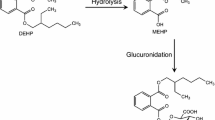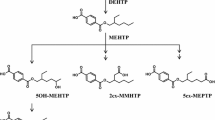Abstract
Acute toxicity of 2,4,4′-trichloro-2′-hydroxydiphenyl ether (Irgasan® DP300) (I) and its three chlorinated derivatives, 2′,3,4,4′-tetrachloro-2-hydroxydiphenyl ether (II), 2′,4,4′,5-tetrachloro-2-hydroxydiphenyl ether (III) and 2′,3,4,4′,5-pentachloro-2-hydroxydiphenyl ether (IV), in mice were examined by intraperitoneal injection. The LD50 values of Irgasan DP300, II, III and IV were 1,090, 710, 650 and 430 mg/kg, respectively.
The percutaneous absorptions of these tritiated compounds were also examined by the application on the backs of mice. The radioactivities in most tissues reached to the maximal levels at 12 h or 18 h after dosing, which corresponded to 11–76% of the maximal levels given by the oral administration (Kanetoshi et al. 1988a). These results show the high percutaneous absorbability of Irgasan DP300 and its chlorinated derivatives.
The intraperitoneal administrations of III and IV to rats induced hepatic microsomal aminopyrine N-demethylase and aniline 4-hydroxylase activities similarly to phenobarbital. These chlorinated derivatives also increased cytochrome P-450 content, and the activities of aminopyrine N-demethylase and N-methylaniline N-demethylase in hepatic microsomes from mice. The extents of the increases were similar to those by phenobarbital and 3-methylcholanthrene.
Similar content being viewed by others
References
Atlas SA, Nebert DW (1976) Genetic association of increases in naphthalene, acetanilide, and biphenyl hydroxylation with inducible aryl hydrocarbon hydroxylase in mice. Arch Biochem Biophys 175:495–506
Atlas SA, Boobis AR, Felton JS, Thougeirsson SS, Nebert DW (1977) Ontogenetic expression of poly aromatic compound-inducible monooxygenase activities and forms of cytochrome P-450 in the rabbit. Evidence for temporal control and organ specificity of two genetic regulatory systems. J Biol Chem 252:4712–4721
Amemiya T, Sakai M, Ikeda K, Mori K, Suzuki S, Watanabe Y (1985) Hygienic chemical studies on household necessities (XVI). Dissolution test of Irgasan DP300 and thiabendazole used as sanitary finishing agent in commercial textile products. Ann Rep Tokyo Metr Res Lab P H 36:123–128
Black JG, Howes D, Rutherford T (1975) Percutaneous absorption and metabolism of Irgasan DP300. Toxicology 3:33–47
Burk MD, Thompson S, Elcombe CR, Halpert J, Haaparanta T, Mayen RT (1985) Ethoxy-, phenoxy- and benzyloxyphenoxasones and Homologues: A series of substrates to distinguish between different induced cytochromes P-450. Biochem Pharmacol 34:3337–3345
Chow AYK, Hirsch GH, Buttar HS (1977) Nephrotoxic and hepatotoxic effects of Triclosan and Chlorhexidine in rats. Toxicol Appl Pharmacol 42:1–10
Guenthner TM, Negishi M, Nebert DW (1979) Separation of Acetanilide and its hydroxylated metabolites and quantitative determination of “acetanilide 4-hydroxylase activity” by high pressure liquid chromatography. Anal Biochem 96:201–207
Imai Y, Ito A, Sato R (1966) Evidence for biochemically different types of versicles in the hepatic microsomal fraction. J Biochem 60:417–428
Kanetoshi A, Ogawa H, Anetai M, Katsura E, Kaneshima H (1985) Studies on the chemicals used in household necessities. I. Analysis of antimicrobial agents in fabrics. Eisei Kagaku 31:245–250
Kanetoshi A, Ogawa H, Katsura E, Kaneshima H (1987) Chlorination of Irgasan DP300 and formation of dioxins from its chlorinated derivatives. J Chromatogr 389:139–153
Kanetoshi A, Ogawa H, Katsura E, Okui T, Kaneshima H (1988a) Disposition and excretion of Irgasan DP300 and its chlorinated derivatives in mice. Arch Environ Contam Toxicol 17:637–644
Kanetoshi A, Ogawa H, Katsura E, Kaneshima H, Miura T (1988b) Formation of polychlorinated dibenzo-p-dioxins upon combustion of commercial textile products containing 2,4,4′,-trichloro-2′-hydroxydiphenyl ether (Irgasan® DP300). J Chromatogr 442:289–299
— (1988c) Formation of polychlorinated dibenzo-p-dioxin from 2,4,4′-trichloro-2′-hydroxydiphenyl ether (Irgasan® DP300) and its chlorinated derivatives by exposure to sunlight. J Chromatogr 454:145–155
Litchfield JT Jr, Wilcoxon F (1949) A simplified method of evaluating dose-effect experiments. J Pharmac Exp Ther 96:99–113
Lowry OH, Resebrough NJ, Farr AL, Randall RJ (1951) Protein measurement with the Folin-phenol reagent. J Biol Chem 193:265–275
Lyman FL, Furia T (1969) Toxicology of 2,4,4′-trichloro-2′-hydroxydiphenyl ether. Indust Med 38:45–52
Miller TL, Lorusso DJ, Deinzer ML (1981) Induction of enzymes of the hepatic mixed-function oxidase system by hydroxychlorodiphenyl ether contaminants of technical pentachlorophenol (Abstract of 65th annual meeting of Federation of American societies for experimental biology). Fed Proc 40:630
Miyazaki T, Yamagishi T, Matsumoto M (1984) Residues of 4-chloro-1-(2,4-dichlorophenoxy)-2-methoxybenzene(triclosan methyl) in aquatic biota. Bull Environ Contam Toxicol 32:227–232
Nash R (1953) The colorimetric estimation of formaldehyde by means of Hantzsch reaction. Biochem J 55:416–421
Nebert DW (1978) Genetic differences affecting microsomal electron transport: The Ah locus. In: Fleischer S, Packer L, (eds) Methods in enzymology vol 52 pp 226–240. Academic Press NY
Nilsson C-A, Andersson K, Rappe C, Westermark S-O (1974) Chromatographic evidence for the formation of chloro-dioxins from chloro-2-phenoxyphenols. J Chromatogr 96:137–147
Omura T, Sato R (1964) The carbon monooxide-binding pigment of liver microsomes. I—Evidence for tis hemoprotein nature. J Biol Chem 239:2370–2378
Ohyama T (1984) Study on induction of drug metabolizing enzyme system by diphenyl ether pesticides. Rep Hokkaido Inst P H 34:8–13
Onodera S, Ogawa M, Suzuki S (1987) Chemical changes of organic compounds in chlorinated water. XIII. Gas chromatographic-mass spectrometric studies of the reactions of Irgasan DP300 [5-chloro-2-(2,4-dichlorophenoxy)phenol] with chlorine in dilute aqueous solution. J Chromatogr 392:267–275
Ullrich V, Weber P (1972) The O-dealkylation of 7-ethoxycoumarin by liver microsomes. Hoppe-Seyler's Z. Physiol Chem 353:1171–1177
Yoshihara S, Yoshimura H (1980) Toxicological aspects of PCB and their related compounds. In: Yamane Y, Takabatake E, Uchiyama M, (eds) Toxicological aspects of environmental pollutants-or-ganic chemicals. Nannkohdo, Tokyo, pp 57–68
Yuge O (1983) The antimicrobial treatments for fabrics. J Antibact Antifung Agents 11:76–81
Author information
Authors and Affiliations
Rights and permissions
About this article
Cite this article
Kanetoshi, A., Katsura, E., Ogawa, H. et al. Acute toxicity, percutaneous absorption and effects on hepatic mixed function oxidase activities of 2,4,4′-trichloro-2′-hydroxydiphenyl ether (Irgasan® DP300) and its chlorinated derivatives. Arch. Environ. Contam. Toxicol. 23, 91–98 (1992). https://doi.org/10.1007/BF00226000
Received:
Revised:
Issue Date:
DOI: https://doi.org/10.1007/BF00226000




